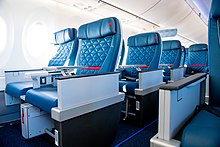First class (aviation)
On a passenger jetliner, first class usually refers to a limited number (rarely more than 10) of seats or cabins toward the front of the aircraft which have more space and comfort, including better service and increased privacy.
As aeroplane design improved, so did the passenger experience, and the airlines concentrated on making flying as comfortable and appealing as possible.
[citation needed] As aeroplanes became larger, and flights more frequent, airlines came to appreciate that if they offered lower fares, they'd get more customers on their planes.
Some airlines have first class seats which allow passengers to let one guest sit for a short time while face-to-face with the occupant of the cabin.
The 2 m (78 inches) bed is separate from the seat and folds out from the back wall, with several other components of the suite lowering to accommodate the mattress.
Etihad Airways introduced a three-room suite called "The Residence" in December 2014 when it added the Airbus A380 to its fleet.
[8] US territories in the Western Pacific (Guam and the CNMI) and sometimes Hawaii are considered international for service purposes and generally feature long-haul business class.
stands for premium service), and "Mint," respectively, with Delta and United using specially configured Boeing 757-200s and American and JetBlue using Airbus A321s.
[citation needed] US discount carriers (such as Southwest and Frontier) do not have first class cabins, instead opting for an all-economy layout, sometimes with a few select rows with extra legroom (such as bulkhead and emergency row seats) available for a fee (or, in the case of Southwest, on a first-come, first-served basis due to their boarding process).
[citation needed] First class service was formerly available on intra-European flights on airlines such as Air France, British Airways, Lufthansa and Swiss International.
[citation needed] Alcoholic and non-alcoholic drinks are complimentary and gourmet meals are usually served with a choice of wine, dessert, and apéritifs.
With the emergence of frequent-flyer programmes, however, passengers have been able to upgrade their business or economy class tickets through membership in elite frequent-flyer programmes and through the policies of some airlines that allow business and economy-class passengers to purchase last-minute upgrades on a space-available basis.





